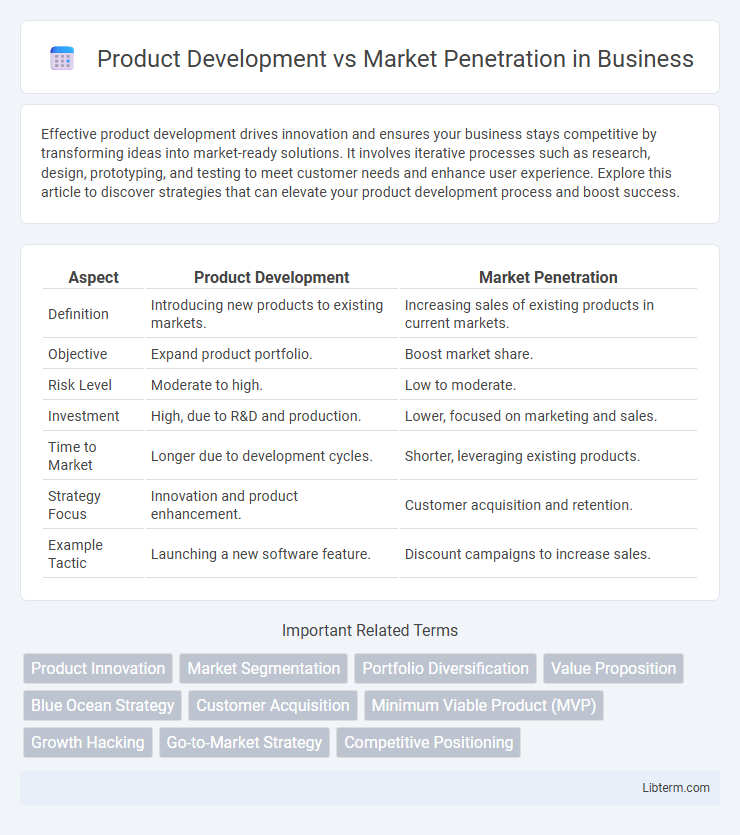Effective product development drives innovation and ensures your business stays competitive by transforming ideas into market-ready solutions. It involves iterative processes such as research, design, prototyping, and testing to meet customer needs and enhance user experience. Explore this article to discover strategies that can elevate your product development process and boost success.
Table of Comparison
| Aspect | Product Development | Market Penetration |
|---|---|---|
| Definition | Introducing new products to existing markets. | Increasing sales of existing products in current markets. |
| Objective | Expand product portfolio. | Boost market share. |
| Risk Level | Moderate to high. | Low to moderate. |
| Investment | High, due to R&D and production. | Lower, focused on marketing and sales. |
| Time to Market | Longer due to development cycles. | Shorter, leveraging existing products. |
| Strategy Focus | Innovation and product enhancement. | Customer acquisition and retention. |
| Example Tactic | Launching a new software feature. | Discount campaigns to increase sales. |
Introduction to Product Development and Market Penetration
Product development involves creating new products or improving existing ones to meet evolving customer needs and expand market reach. Market penetration focuses on increasing sales of current products within existing markets by enhancing marketing strategies, pricing tactics, or distribution channels. Both strategies aim to boost business growth but differ in whether they target product innovation or optimizing market share.
Defining Product Development
Product development refers to the process of designing, creating, and bringing new or improved products to the market to meet evolving customer needs and preferences. It involves extensive research, design iterations, and testing to ensure the product aligns with market demands and business objectives. This strategy emphasizes innovation and differentiation to capture new customer segments or enhance market share through novel offerings.
Understanding Market Penetration
Market penetration measures the percentage of potential customers who have purchased a product or service within a specific market, indicating a company's success in capturing market share. It emphasizes increasing sales of existing products to current markets through strategies such as competitive pricing, advertising, and distribution improvements. High market penetration reflects strong brand presence and customer loyalty, often leading to increased revenue without the cost of product development.
Key Differences Between Product Development and Market Penetration
Product development involves creating new products or significantly improving existing ones to meet market needs, focusing on innovation and R&D investment. Market penetration emphasizes increasing sales of existing products within the current market through competitive pricing, promotional strategies, and expanding distribution channels. The key difference lies in product development targeting product innovation, while market penetration focuses on boosting market share with existing products.
Strategic Objectives: When to Choose Product Development
Choose product development as a strategic objective when targeting existing markets with innovative or improved products to increase customer satisfaction and gain competitive advantage. This approach is ideal for companies seeking growth by leveraging market knowledge while differentiating their product offerings. Product development supports long-term brand loyalty and revenue expansion in mature or saturated markets.
Strategic Objectives: When to Focus on Market Penetration
Market penetration should be the strategic focus when a company aims to increase sales of existing products within current markets to boost market share rapidly. This approach is optimal in saturated markets where efforts concentrate on outperforming competitors through enhanced marketing, pricing strategies, and customer loyalty programs. Prioritizing market penetration enables businesses to maximize revenue from established customer bases before exploring new product development.
Benefits of Product Development Strategies
Product development strategies drive innovation by introducing new features or entirely new products, meeting evolving customer needs and enhancing brand competitiveness. These strategies increase market share by attracting new customer segments and encouraging existing customers to upgrade or diversify their purchases. Investing in product development also fosters long-term growth through continuous improvement and adaptation to technological advancements.
Advantages of Market Penetration Tactics
Market penetration tactics offer significant advantages by maximizing the potential of existing products within current markets, reducing the risks and costs associated with new product development. These strategies enhance brand loyalty and increase market share through targeted marketing, competitive pricing, and improved customer engagement. Companies leveraging market penetration benefit from accelerated revenue growth and stronger market presence without the uncertainties of product innovation.
Challenges and Risks for Both Approaches
Product development faces challenges such as high R&D costs, uncertain customer acceptance, and longer time-to-market, posing risks of resource misallocation and product failure. Market penetration risks include increased competitive pressure, potential price wars, and market saturation, which can limit growth and reduce profit margins. Both strategies require careful risk management to balance innovation investment against aggressive market share expansion.
Choosing the Right Growth Strategy for Your Business
Selecting the appropriate growth strategy depends on your business's current market position and product lifecycle. Product development emphasizes creating new or improved offerings to meet evolving customer needs, while market penetration focuses on increasing sales of existing products within the current market segment through pricing, promotion, or distribution enhancements. Businesses aiming for sustainable expansion must analyze market saturation levels, competitive intensity, and customer demand trends to decide whether innovation or deeper market engagement offers the highest return on investment.
Product Development Infographic

 libterm.com
libterm.com